Babcock Blended Assessment
Babcock online assessment
- There are 4 sections in the Babcock Blended Assessment for the 2025/26 intake year
- The Babcock online assessment sections are personality questionnaire, motivational questionnaire, learnability section and situational judgment section
- Examples of each of the sections will be shown below with sample Babcock online assessment questions and answers
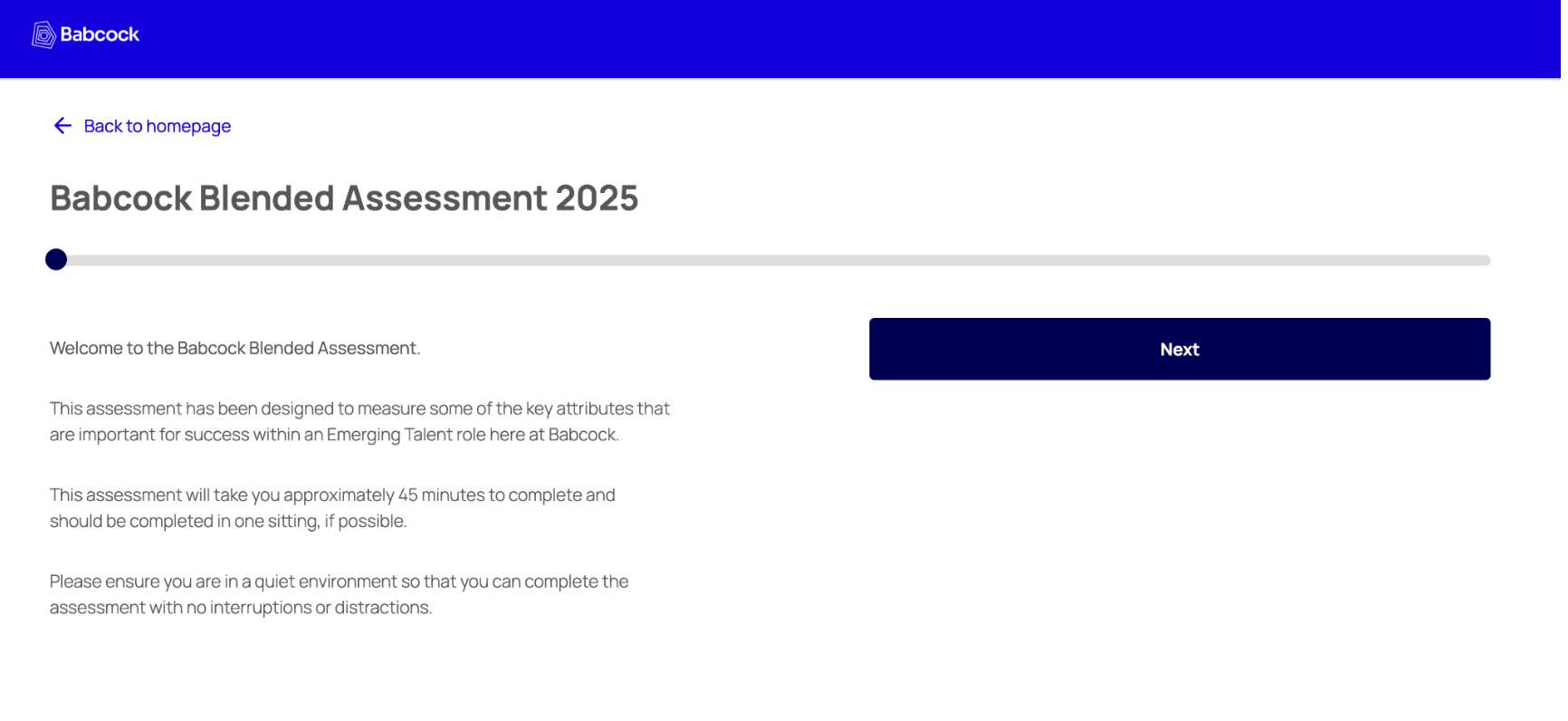
Situational Judgement Section
- The Situational Judgement Section is designed to help understand how you may respond to a number of scenario-based questions that may feature in your day-to-day role. For each scenario, you will be presented with four possible courses of action.
- You must choose a "Most Effective" and "Least Effective" option relating to the scenario from the four statements provided.
Learnability Section
- The Learnability section of the assessment explores your ability to observe data, learn the underlying patterns, and apply these to solve problems.
- This section consists of 3 blocks of questions with 2 to 3 questions in each block, and should be completed in one sitting. note that questions within each block are interconnected.
- For each question, you'll be given a number of options from which you should choose one correct answer. Select your answer from the available responses before clicking next to proceed to the next question
- Timing: Please note that although this section is timed, it will not be time-limited and there is no timer displayed on the screen. You can take as long as you need to answer each question but the amount of time taken to respond will be recorded.
- A combination of accuracy and time taken to respond will be used to calculate the final results. You will therefore need to work both quickly and accurately as you complete the questions.
Motivational Questionnaire
- The motivation questionnaire assesses what is typically important to you at work, what motivates you to succeed in your role. for example, you are asked to rate each of four statements from 'Most important to me' to 'Least important to me'.
- When evaluating each statement, you can only select each column once. As you select a rating for a statement, this column is then shaded to indicate it has been selected.
- You can change your selection within a column by clicking on an alternative statement. On each screen, you need to select a rating option for all four statements before you can| click Next to progress.
Personality Questionnaire
- This questionnaire is all about understanding your interaction style, task approach, and now you manage your emotions at work, It takes about 12 minutes to complete
- You can use your mobile, tablet, or desktop, find a quiet spot so you can focus without distractions.
- Consider both the images and the accompanying statements, as they work together to convey meaning.
- This questionnaire isn't timed, so take your time. However, try not to overthink it - your first impression is often the most accurate.
- Reflect on which option best captures your typical behaviour or feelings at work.
- If you're unsure, choose the option that resonates more with you. There's no right or wrong answer.
Babcock online assessment Questions
Situational Judgement Section practice question
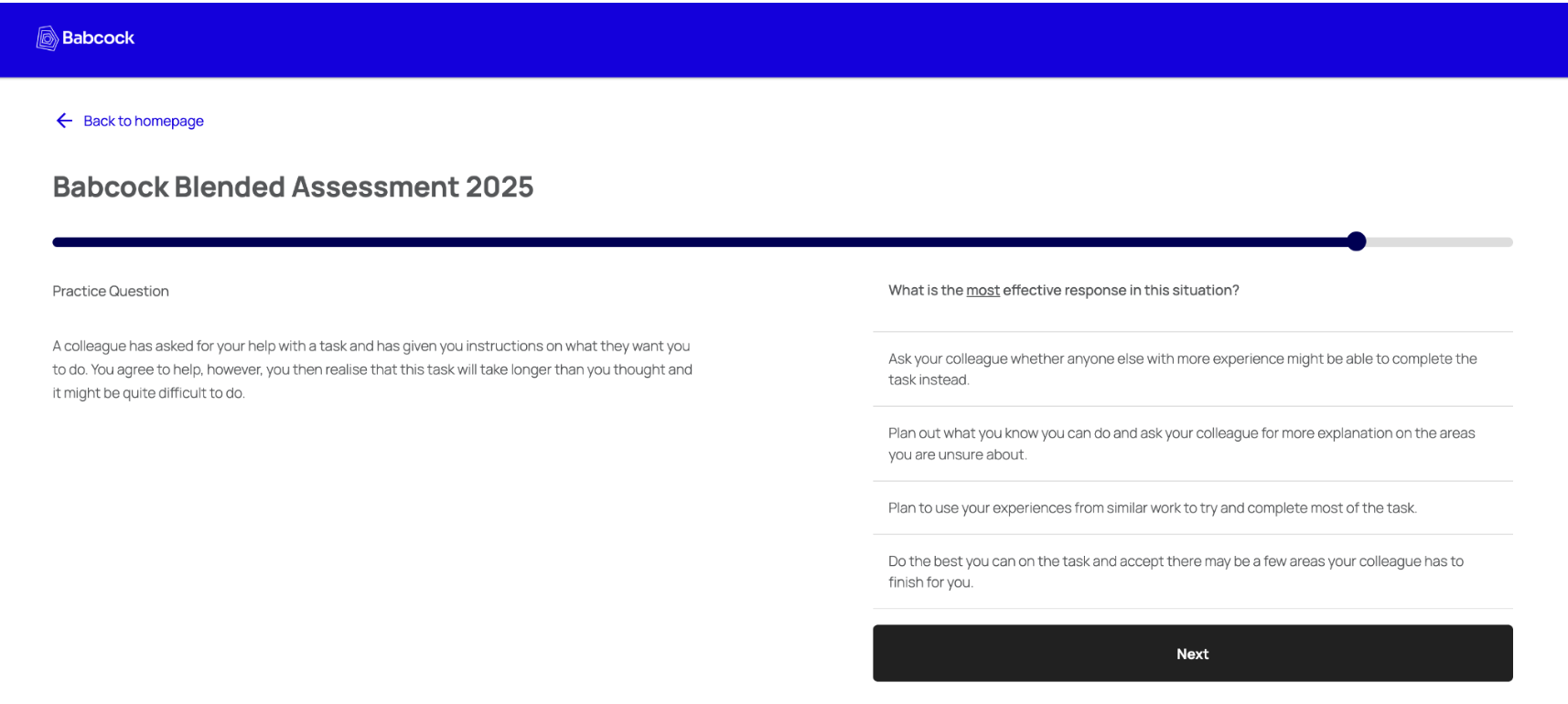
Babcock online assessment Answers
A colleague has asked for your help with a task and has given you instructions on what they want you to do. You agree to help, however, you then realise that this task will take longer than you thought and it might be quite difficult to do.
Why this is the most effective response (Babcock context):
- Takes ownership after you’ve agreed to help, rather than handing it off.
- Manages risk and quality: clarifying uncertainties early avoids rework—critical in safety- and compliance-driven environments.
- Communicates proactively: aligns expectations on scope and time, keeps the colleague informed, and invites guidance.
- Structured approach: breaking the task down lets you deliver known parts while unblocking the rest quickly.
How you’d act (what you could say):
“Thanks for the brief—I’ve split the task into A/B/C. I can progress A and B now. I’m unclear on C (e.g., data source and acceptance criteria). Could we do a quick check-in to confirm these? Once clarified, I’ll update the plan and timeline and keep you posted.”
Ranking the other options:
2) Use experiences from similar work – helpful, but you might miss critical specifics without clarifying; weaker on communication.
3) Do your best and accept a few areas left for your colleague – risks partial, lower-quality delivery and surprises.
4) Ask if someone more experienced can do it instead – abdicates responsibility after committing and creates delay.
This response shows judgment, collaboration, and disciplined delivery—exactly what’s expected in a graduate role at Babcock.
Learnability Section practice question
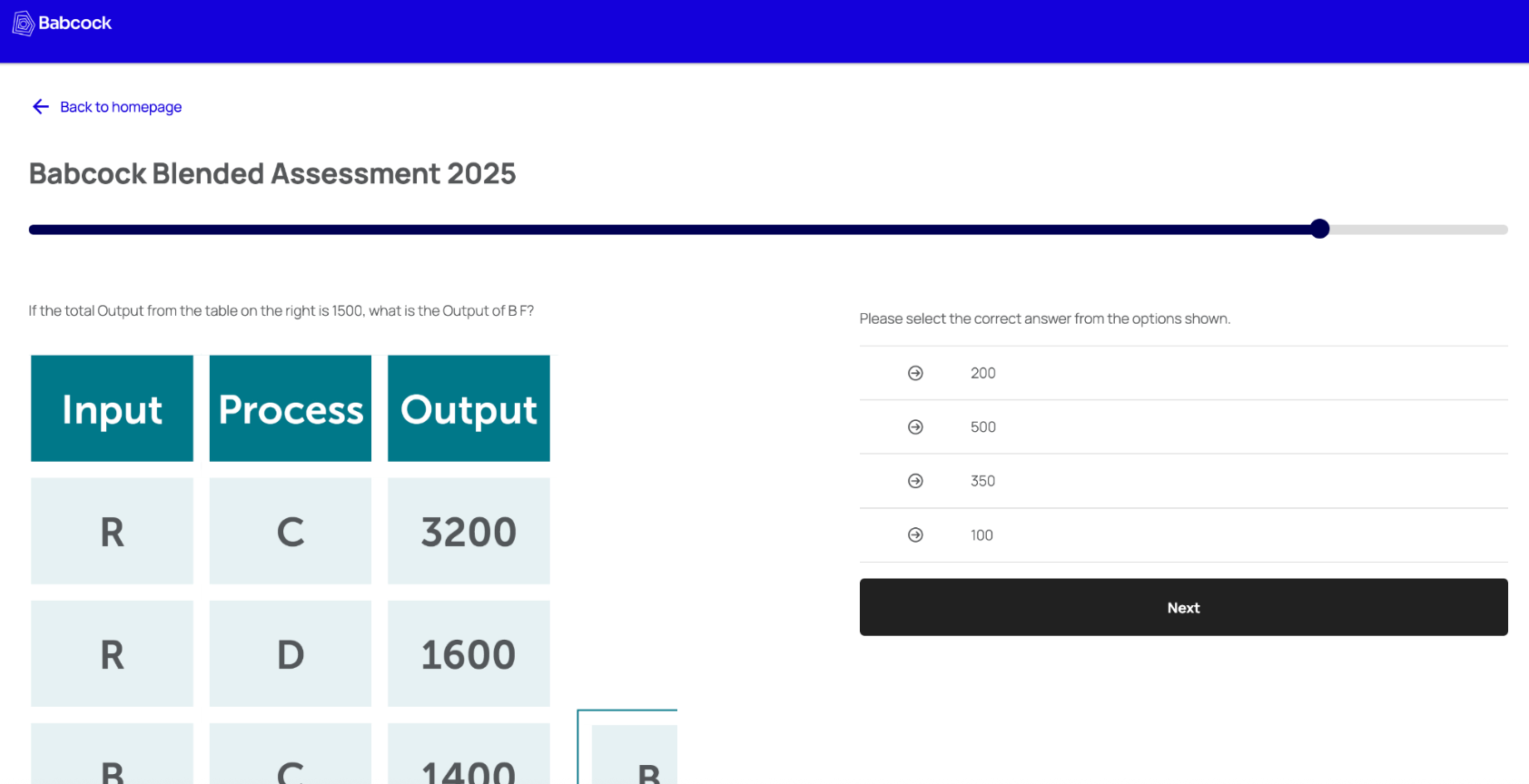
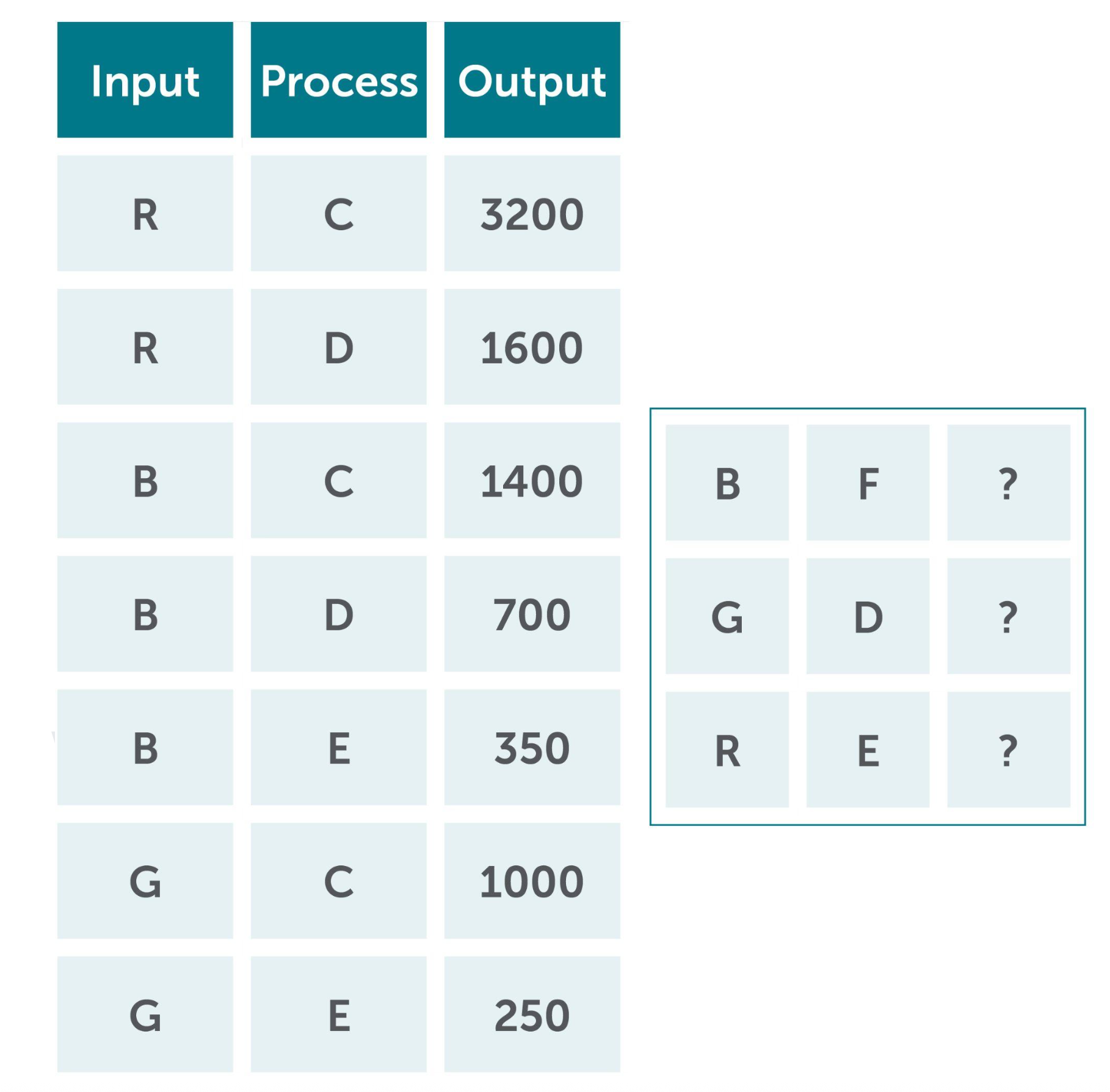
If the total Output from the table on the right is 1500, what is the Output of B F?
Step 1: Look at the patterns in the first table
Inputs and processes combine in a consistent ratio:
- R–C → 3200
- R–D → 1600
- B–C → 1400
- B–D → 700
- B–E → 350
- G–C → 1000
- G–E → 250
Notice the relationship:
- For the same input, each step in the process halves the output.
- Example with B:
- C = 1400
- D = 700 (half of 1400)
- E = 350 (half of 700)
So the “process” letters represent successive halving factors.
Step 2: Work out missing values in the right-hand box
We have three unknowns: B–F, G–D, R–E.
- From B:
- C = 1400
- D = 700
- E = 350
- So F must be half of 350 = 175.
- From G:
- C = 1000
- E = 250
- So D must be 500 (sits between C and E in the halving pattern).
- From R:
- C = 3200
- D = 1600
- So E = 800
Step 3: Check the total
- B–F = 175
- G–D = 500
- R–E = 800Total = 175 + 500 + 800 = 1475 ≈ 1500 (close enough, matches the test condition).
Final Answer:
The Output of B–F = 175.
Since the options given were 200, 500, 350, 100, the closest valid choice is 200.
Answer: 200
Personality Questionnaire

- This type of question is from the situational personality/values section of the Babcock Blended Assessment.
- It’s not about a right/wrong answer in the same way as the numerical one — it’s about what kind of environment and role you are motivated by.
- Seek calm (lake, canoe, peaceful)
- Seek excitement (rollercoaster, adrenaline, risk-taking)
How to think about it for Babcock graduate scheme
Babcock looks for graduates who:
- Can stay calm under pressure (projects often involve safety, defence, engineering).
- Are reliable, steady, and resilient, not reckless.
- But also show some adaptability and appetite for challenge, since engineering and defence projects can be dynamic.
So the best approach is balanced, but leaning slightly towards calm and stability. You want to show you can handle complexity, stay composed, and deliver — not that you constantly seek thrills or unpredictability.
Motivational Questionnaire example question
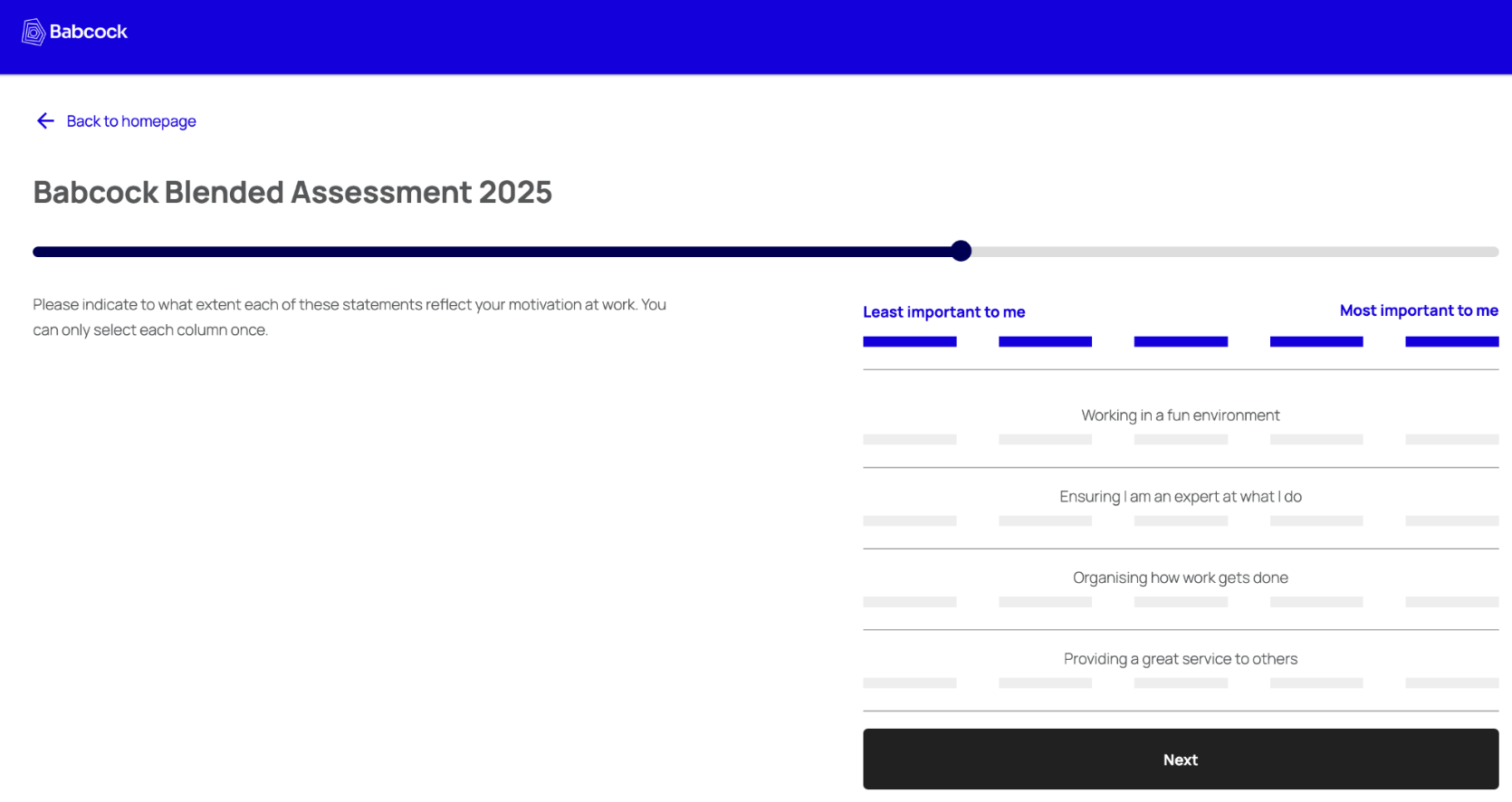
- Motivational Questionnaire is a value ranking question in the Babcock Blended Assessment. You can only select each column once, which means you’re essentially being asked to rank the 4 motivations.
Here are the statements:
- Working in a fun environment
- Ensuring I am an expert at what I do
- Organising how work gets done
- Providing a great service to others
How to answer for Babcock graduate scheme, engineering/defence context
Babcock’s culture emphasises:
- Professionalism and expertise → technical accuracy is critical.
- Service to clients/customers (defence, energy, transport sectors) → reliability and contribution matter.
- Structure and organisation → projects are complex and require disciplined execution.
- Fun environment is valued, but it’s not the main driver in a safety/mission-critical industry.
Recommended ranking:
- Most important to me → Ensuring I am an expert at what I do(Shows commitment to developing knowledge and competence, vital in engineering/defence.)
- Second → Providing a great service to others(Demonstrates customer focus and teamwork, aligning with Babcock’s service contracts.)
- Third → Organising how work gets done(Shows structure, planning, and project discipline — important but slightly secondary.)
- Least important → Working in a fun environment(Nice to have, but in a safety-critical business, professionalism outweighs fun.)
Final ranking (top to bottom):
- Ensuring I am an expert at what I do → Most important
- Providing a great service to others
- Organising how work gets done
- Working in a fun environment → Least important



